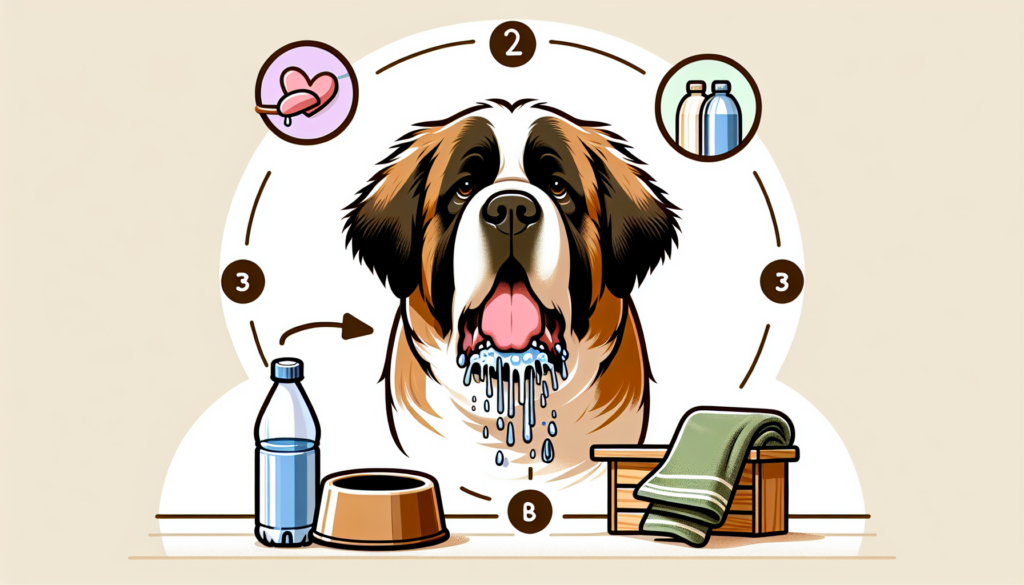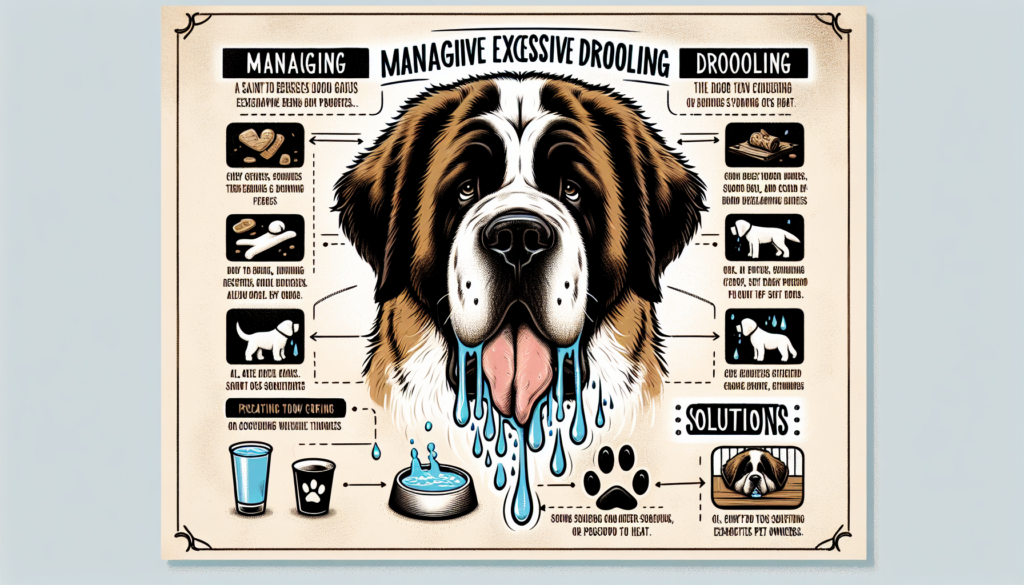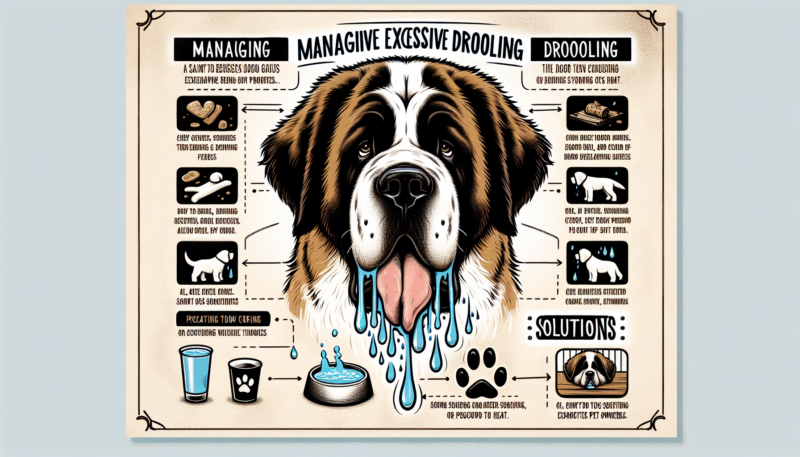If you are a proud owner of a lovable Saint Bernard, you may have noticed their tendency to drool more than any other dog breed. While this excessive drooling can be a bit messy and inconvenient at times, there are ways to effectively manage and handle this common trait. In this article, we will explore some practical tips and techniques that will help you keep your home clean and your furry friend comfortable, so you can focus on enjoying the delightful companionship of your beloved Saint Bernard.
Understanding Excessive Drooling in Saint Bernards
Saint Bernards are known for their large droopy jowls and, as a result, excessive drooling is a common characteristic of this breed. While some drooling is normal for Saint Bernards, excessive drooling can be a cause for concern. In this comprehensive article, we will explore the causes of excessive drooling, health issues that can contribute to it, and provide preventive measures, training approaches, and grooming tips to manage and reduce excessive drooling in your beloved furry friend.

Causes of Excessive Drooling
Excessive drooling in Saint Bernards can be attributed to several factors. One common cause is genetics. The breed’s large, loose lips and heavy jowls often result in excess salivation. Additionally, environmental factors such as temperature and humidity can play a role. When Saint Bernards become overheated or stressed, they may drool excessively as a way to regulate their body temperature or cope with anxiety.
Health Issues that Can Contribute to Excessive Drooling
While drooling is generally a natural behavior for Saint Bernards, certain health problems can lead to an increase in drooling. Dental issues like gum infections, dental abscesses, or periodontal disease can cause discomfort and excessive drooling. Other conditions such as tongue injuries, oral tumors, or gastrointestinal problems can also contribute to increased salivation. It is essential to identify any underlying health issues to properly address and manage excessive drooling.
Normal Drooling vs. Excessive Drooling
Understanding the difference between normal and excessive drooling is paramount in gauging your Saint Bernard’s health. Normal drooling typically occurs when your dog is eating, drinking, or anticipating food. It is expected for the breed and does not usually cause any concern. On the other hand, excessive drooling is characterized by a significant increase in saliva production compared to what is considered normal for Saint Bernards. If you notice that your dog’s drooling has suddenly intensified or is unrelated to eating or drinking, it may be necessary to seek veterinary guidance.
Preventive Measures to Reduce Excessive Drooling
Fortunately, there are several preventive measures you can take to reduce excessive drooling in your Saint Bernard. By implementing proper dental care and hygiene practices, feeding techniques, and minimizing stress and anxiety, you can help keep drooling at a manageable level.
Regular Dental Care and Hygiene
Maintaining good oral hygiene is crucial in preventing dental issues that can lead to excessive drooling. Brush your Saint Bernard’s teeth regularly using a dog-friendly toothbrush and toothpaste. Additionally, provide dental chews or toys designed to promote dental health. Regular dental check-ups with your veterinarian are also essential to detect any potential dental problems early.
Proper Feeding Techniques
Feeding your Saint Bernard in a controlled and structured manner can help reduce drooling. Avoid feeding your dog from elevated bowls, as this can cause excessive swallowing of air, leading to increased salivation. Instead, opt for bowls placed at ground level. Additionally, feeding smaller, more frequent meals instead of one large meal can help minimize drooling episodes.
Avoiding Stress and Anxiety
Just like humans, dogs can experience stress and anxiety, which may lead to excessive drooling. Being mindful of your dog’s triggers and providing a calm and structured environment can help alleviate stress. Provide a designated safe space for your Saint Bernard and engage in calming activities such as gentle exercises or bonding through playtime to reduce anxiety levels.

Training and Behavioral Approaches
Training your Saint Bernard using positive reinforcement techniques can be highly effective in managing excessive drooling. By teaching the ‘Leave It’ command, using interactive toys and puzzles for mental stimulation, and employing positive reinforcement training methods, you can redirect your dog’s attention and reduce drooling episodes.
Teaching the ‘Leave It’ Command
The ‘Leave It’ command is invaluable in preventing your Saint Bernard from fixating on stimuli that may trigger excessive drooling. Start by teaching your dog to respond to the command when presented with tempting items or situations. Reward your dog with treats and praise when they successfully comply, gradually increasing the distractions as your dog becomes more proficient. This command not only helps prevent drooling triggers but also promotes overall obedience and focus.
Using Interactive Toys and Puzzles
Mental stimulation through interactive toys and puzzles can divert your dog’s attention away from drooling triggers. Engage your Saint Bernard with toys that dispense treats or require problem-solving skills. These toys not only provide entertainment but also challenge your dog’s mind, helping to reduce anxiety and excessive drooling.
Positive Reinforcement Training
Positive reinforcement training techniques can be used to reward desired behaviors and discourage excessive drooling. When your Saint Bernard displays calm behavior or refrains from drooling triggers, praise and reward them with treats or verbal affirmations. Consistency and patience are key in reinforcing positive behavior and reducing drooling episodes.
Managing Excessive Drooling in Everyday Life
While preventive measures and training approaches can help reduce excessive drooling, managing it in everyday life is equally important. Here are some tips to incorporate into your daily routine:
Providing Ample Fresh Water
To prevent dehydration and maintain your Saint Bernard’s overall health, always ensure a fresh and clean water supply is readily available. Excessive drooling can often lead to increased thirst, so monitoring your dog’s water consumption and regularly refilling their water bowl is essential.
Maintaining a Clean Living Environment
Excessive drooling can result in sticky and messy living conditions. Regularly clean your Saint Bernard’s living area, including floors, walls, and furniture, to prevent the buildup of drool. Using pet-safe cleaners will help maintain hygiene and prevent any unpleasant odors.
Using Drool Rags and Towels
Having designated drool rags or towels on hand can be immensely helpful in managing drooling episodes. Keep these within reach and readily available to wipe your dog’s mouth during excessive drooling. This not only helps maintain cleanliness but also prevents discomfort and irritation caused by excessive moisture.
Grooming and Maintenance Tips
Proper grooming is crucial in managing excessive drooling in Saint Bernards. By regularly brushing and grooming your dog’s facial hair, trimming their facial hair to minimize drool accumulation, and keeping their facial folds clean, you can help mitigate drooling and promote good overall hygiene.
Regular Brushing and Grooming Sessions
Brushing your Saint Bernard’s coat helps remove loose hair and prevents matting, which can trap drool. Pay special attention to the facial area, gently brushing the jowls, chin, and muzzle. Regular grooming sessions also provide an opportunity to inspect for any skin irritations or abnormalities that may contribute to excessive drooling.
Trimming Facial Hair
Keeping the facial hair of your Saint Bernard trimmed can significantly reduce the accumulation of drool. Long facial hair tends to trap saliva, leading to a messy and uncomfortable experience for your dog. Consult a professional groomer to determine the appropriate length and style for your dog’s facial hair.
Keeping the Facial Folds Clean
Saint Bernards have adorable facial folds that can become a breeding ground for bacteria and yeast if not properly maintained. Regularly clean these folds using a damp cloth or gentle pet-safe wipes, ensuring you reach all the crevices. This not only helps prevent excessive drooling but also reduces the risk of skin infections and discomfort for your dog.
Consulting with a Veterinarian
If your Saint Bernard continues to experience excessive drooling despite preventive measures and lifestyle adjustments, it is essential to consult with a veterinarian. They will be able to assess your dog’s health, determine any underlying issues, and provide professional advice on management techniques tailored to your dog’s specific needs.
Determining Underlying Health Issues
Your veterinarian will conduct a thorough examination to identify any potential health issues contributing to excessive drooling. They may recommend specific tests, such as dental x-rays or blood work, to rule out underlying conditions like dental disorders, oral tumors, or gastrointestinal problems.
Professional Advice on Management Techniques
Based on your dog’s individual circumstances, your veterinarian will provide tailored advice on managing excessive drooling. They may suggest additional preventive measures, dietary changes, or behavioral modifications to help reduce drooling and improve your dog’s overall well-being.
Exploring Medical Treatment Options
In certain cases, medical treatment may be necessary to address excessive drooling. Your veterinarian may prescribe medications to alleviate underlying conditions contributing to drooling or recommend oral health treatments, such as dental cleanings, surgeries, or extractions. Always follow your veterinarian’s guidance and recommendations for your dog’s specific needs.
Addressing Dental Problems
Dental problems can significantly contribute to excessive drooling in Saint Bernards. Regular dental care and professional interventions are essential to maintain oral health and reduce drooling episodes.
Regular Dental Check-ups
Schedule regular dental check-ups with your veterinarian to monitor your Saint Bernard’s dental health. Routine examinations allow for early detection of dental issues and prompt intervention to prevent further discomfort and excessive drooling.
Professional Dental Cleaning
Professional dental cleanings performed by a veterinarian are necessary to remove plaque and tartar buildup that can contribute to oral infections and excessive drooling. These cleanings are usually done under anesthesia, ensuring a thorough and safe procedure.
Handling Dental Surgeries or Extractions
In severe cases, dental surgeries or extractions may be required to alleviate dental problems causing excessive drooling. Your veterinarian will assess the situation and determine the most appropriate treatment options. Follow their post-operative care instructions diligently to promote a smooth recovery for your beloved Saint Bernard.
Assessing Diet and Nutrition
Proper nutrition plays a vital role in managing excessive drooling. Ensuring your Saint Bernard receives a balanced diet that meets their specific nutritional requirements can positively impact their overall health and reduce drooling episodes.
Choosing the Right Dog Food
Consult with your veterinarian to select a high-quality dog food that addresses your Saint Bernard’s specific needs. Consider factors such as age, weight, and any known allergies or sensitivities. Quality dog foods help maintain good oral health and reduce the likelihood of dental problems contributing to excessive drooling.
Avoiding Food Allergies
Some dogs may develop food allergies that can contribute to excessive drooling. Be aware of any potential food allergens such as grains, chicken, or beef, and opt for hypoallergenic dog foods if necessary. If you suspect a food allergy, consult with your veterinarian to determine the most appropriate diet for your dog.
Supplements and Probiotics for Oral Health
Certain supplements and probiotics can support oral health and reduce excessive drooling. Discuss with your veterinarian the suitability of these supplements for your Saint Bernard. They may recommend oral health supplements containing ingredients like omega-3 fatty acids or probiotics to promote a healthy mouth and reduce drooling.
Considering Natural Remedies
If you prefer a more natural approach to managing excessive drooling, there are several homeopathic remedies, herbal supplements, and aromatherapy options that may help. It is essential to consult with your veterinarian before introducing any natural remedies to ensure they are safe and appropriate for your dog.
Homeopathic Remedies for Excessive Drooling
Some homeopathic remedies, such as herbal tinctures or essential oil blends, may help reduce excessive drooling. Chamomile, a well-known calming herb, can be administered in diluted form to help ease anxiety and minimize drooling. However, always consult with a holistic veterinarian experienced in homeopathy before trying any natural remedies.
Herbal Supplements and Treatments
Certain herbal supplements, such as marshmallow root or ginger, can have anti-inflammatory or calming properties that may help reduce drooling. Herbal rinses or sprays specifically formulated for oral health can also be beneficial. However, as with any natural supplements, it is imperative to consult with your veterinarian before incorporating them into your dog’s routine.
Aromatherapy for Anxiety Reduction
Aromatherapy can be a useful tool in reducing anxiety-related drooling. Essential oils like lavender or chamomile can have calming effects when properly diluted and used in a diffuser or applied to a bandana or collar. Always ensure the essential oils you use are safe for dogs and consult with a trained aromatherapist or veterinarian for guidance.
When to Seek Professional Help
While excessive drooling is common in Saint Bernards, there are instances when professional help should be sought. Pay attention to the following signs that may indicate a need for immediate veterinary evaluation:
Persistent and Unexplained Excessive Drooling
If your Saint Bernard’s drooling persists or intensifies over time without an apparent cause, it is essential to consult with a veterinarian. Persistent and unexplained excessive drooling can be a symptom of underlying health issues or dental problems requiring professional attention.
Abnormal Behavioral Changes
Excessive drooling accompanied by abnormal behavioral changes, such as aggression, lethargy, or loss of appetite, may indicate a more serious underlying problem. These changes should be evaluated by a veterinarian to ensure your dog’s well-being.
Increasing Discomfort or Pain
If your Saint Bernard shows signs of discomfort or pain alongside excessive drooling, it is crucial to seek immediate veterinary care. Excessive drooling combined with behaviors like pawing at the mouth, whining, or reluctance to eat may indicate dental issues or oral injuries that require prompt attention.
Remember, as a responsible and caring Saint Bernard owner, you play a vital role in understanding, managing, and reducing excessive drooling in your furry companion. By following the preventive measures, training approaches, and grooming tips outlined in this article, and seeking professional guidance when necessary, you can ensure your Saint Bernard remains happy, healthy, and drool-free.
